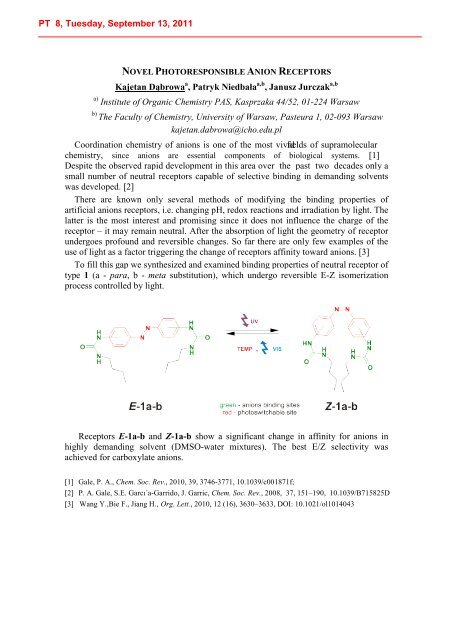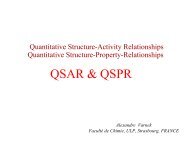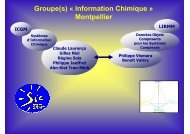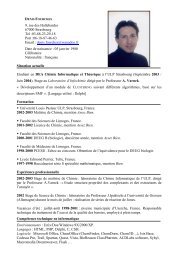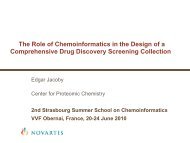International Summer School PROGRAM - Laboratoire d'Infochimie ...
International Summer School PROGRAM - Laboratoire d'Infochimie ...
International Summer School PROGRAM - Laboratoire d'Infochimie ...
You also want an ePaper? Increase the reach of your titles
YUMPU automatically turns print PDFs into web optimized ePapers that Google loves.
NOVEL PHOTORESPONSIBLE ANION RECEPTORS<br />
Kajetan Dąbrowa a , Patryk Niedbała a,b , Janusz Jurczak a,b<br />
a) Institute of Organic Chemistry PAS, Kasprzaka 44/52, 01-224 Warsaw<br />
b)<br />
The Faculty of Chemistry, University of Warsaw, Pasteura 1, 02-093 Warsaw<br />
kajetan.dabrowa@icho.edu.pl<br />
Coordination chemistry of anions is one of the most vivid fields of supramolecular<br />
chemistry, since anions are essential components of biological systems. [1]<br />
Despite the observed rapid development in this area over the past two decades only a<br />
small number of neutral receptors capable of selective binding in demanding solvents<br />
was developed. [2]<br />
There are known only several methods of modifying the binding properties of<br />
artificial anions receptors, i.e. changing pH, redox reactions and irradiation by light. The<br />
latter is the most interest and promising since it does not influence the charge of the<br />
receptor – it may remain neutral. After the absorption of light the geometry of receptor<br />
undergoes profound and reversible changes. So far there are only few examples of the<br />
use of light as a factor triggering the change of receptors affinity toward anions. [3]<br />
To fill this gap we synthesized and examined binding properties of neutral receptor of<br />
type 1 (a - para, b - meta substitution), which undergo reversible E-Z isomerization<br />
process controlled by light.<br />
Receptors E-1a-b and Z-1a-b show a significant change in affinity for anions in<br />
highly demanding solvent (DMSO-water mixtures). The best E/Z selectivity was<br />
achieved for carboxylate anions.<br />
[1] Gale, P. A., Chem. Soc. Rev., 2010, 39, 3746-3771, 10.1039/c001871f;<br />
[2] P. A. Gale, S.E. Garcı´a-Garrido, J. Garric, Chem. Soc. Rev., 2008, 37, 151–190, 10.1039/B715825D<br />
[3] Wang Y.,Bie F., Jiang H., Org. Lett., 2010, 12 (16), 3630–3633, DOI: 10.1021/ol1014043


